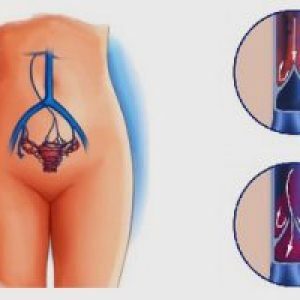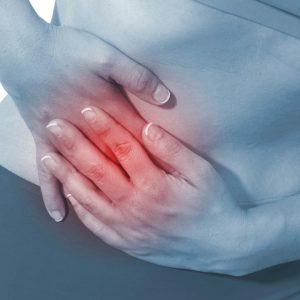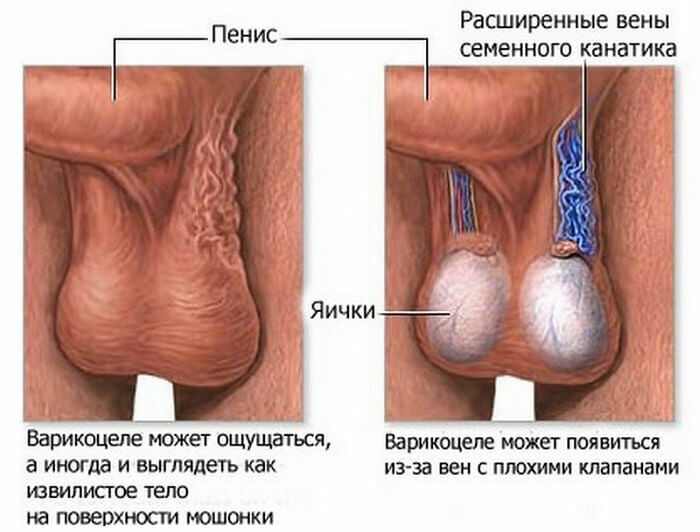Varicose veins of the pelvis in women: symptoms and treatment

Varicose veins of the pelvis in women are a common problem, which is particularly affected by the fair sex who are of childbearing age.The provoking factors of the disease are numerous and varied, but the features of therapy depend on them.
Table of contents: Brief description of the disease What is the cause?Varicose veins of the pelvis in pregnant women Symptoms of varicose veins of the small pelvis What is dangerous disease?Diagnostic measures Treatment of varicose veins of the small pelvisBrief description of the disease
Varicose veins are vascular enlargement, affecting the pelvic organs.With the expansion of veins, nerve endings are clamped, which leads to the development of pain syndrome. The pathological process, according to the international classification, can have two following forms:
- Primary - characterized by an increase in the blood vessels of the pelvic organs.
- Secondary - accompanied by a thickening of the veins in the pelvic region and develops against the backdrop of pathologies of a gynecological nature.
The disease develops gradually and requires mandatory professional medical care!
Important! Varicose veins of the pelvic veins are fraught with the development of extremely dangerous complications, therefore, the earlier the therapeutic course for this disease is initiated, the more likely the patient will have the outcome of the !
Where does it come from?
The varicose veins of the pelvis can occur in the fair sex under the influence of factors such as hereditary predisposition, gynecological diseases, etc.
Among the main and most common causes of this ailment, doctors distinguish the following :
- dysplasia of connective tissueStructures;
-
 genetic predisposition;
genetic predisposition; - is a sedentary lifestyle;
- insufficient motor activity;
- hormonal disorders associated with elevated estrogen hormone;
- weight lifting;
- tumor neoplasms of benign or malignant origin, localized in the ovaries;
- gynecological diseases of inflammatory nature;
- numerous pregnancies;
- heavy delivery;
- lack of regular and full-fledged sex life;
- long and uncontrolled reception of contraceptives of the hormonal group;
- frequent interruption of intimate contact in order to prevent unwanted pregnancies;
- disorders of the menstrual cycle;
- obesity;
- frequent and excessively intense physical activity.
Note: the main cause of varicose veins is the pathological changes in connective tissue structures!
Varicose veins of the small pelvis in pregnant women
According to statistics, the varicose extension of pelvic veins is most affected by the fair sex, who are preparing to become mothers. The fact is that when a baby is born, the weight category of a woman increases noticeably, and the volumes of circulating blood also increase.As a result, the vascular walls expand, which leads to disturbances in the work of venous valves and the appearance of stagnant phenomena.
In addition, gynecologists identify a number of reasons that can provoke an expansion of the pelvic floor in pregnant women.
These factors include:
- changes in hormonal patterns;
- increase in internal pressure in the pelvic area;
- uterine enlargement, due to the growth of the child.
 Important! Varicose veins in expectant mothers are threatened with inflammatory processes that pose a serious threat to life, both for the woman herself and her future baby!
Important! Varicose veins in expectant mothers are threatened with inflammatory processes that pose a serious threat to life, both for the woman herself and her future baby!
For this reason, with the appearance of the first characteristic signs of a woman expecting the birth of a baby, it is necessary, without a hitch, to contact the doctor for professional advice and the appointment of the optimal medical course !In most cases, pregnant women with diagnosed varicose veins of the pelvic veins are recommended to have a caesarean section!
Symptoms of varicose veins of the small pelvis
In the first stages of the pathological process, varicose veins in the fair sex are manifested by severe pain, localized in the lower abdomen, as well as the emergence of a large number of specific vaginal discharge. Pain can often be given to the groin and lumbar region.
In addition, this pathology is characterized by the presence of the following clinical signs:
-
 menstrual irregularities;
menstrual irregularities; - manifestations characteristic of premenstrual syndrome;
- increased urge to urinate;
- increased perineal sensitivity;
- general weakness;
- increased fatigue;
- bloody vaginal discharge;
- uterine bleeding;
- painful urination process;
- unpleasant, painful sensations when having sexual intercourse.
With further progression of the pathological process, symptoms appear such as swelling of the vaginal area, a feeling of heaviness and discomfort in the pelvis, an increase in venous nodes localized in the buttocks, perineum and inner thigh.
Note: is symptomatic of varicose veins in the pelvis in many respects descending with manifestations of other dangerous pathologies, such as uterine myoma, endometriosis, prolapse of the uterus.Therefore, to put the right diagnosis and prescribe an effective treatment for a specific clinical case, the treatment will be able only by a qualified specialist, after preliminary complex diagnostics!
What is the danger of the disease?
In the field of pelvic varicosity in women, in the absence of adequate and timely treatment, can lead to the development of the following, undesirable complications:
- venous thrombosis;
- uterine bleeding;
- disorders in the functioning of the urinary system;
- Inflammation of the uterus and uterine appendages.
Please note: according to statistical data, in 80% of cases with timely access to a specialist and strict compliance with medical recommendations, patients managed to achieve positive results of treatment, without accompanying complications!
Avoiding the development of such undesirable consequences and reducing possible risks to minimum indicators will allow a competent therapeutic course begun at the early stages of the development of the pathological process!
Diagnostic measures
Diagnosis of pelvic varicose veins begins with a study of the clinical picture, symptoms and the results of the collected anamnesis.
However, in order to provide an accurate diagnosis, the patient is assigned the following types of studies:
-
 ultrasound examination of the venous system;
ultrasound examination of the venous system; - computed tomography, which allows to detect the presence of venous nodes in the ovaries and uterus;
- dopplerography;
- Laparoscopy to detect ovarian varices;
- Ovaricography selective - the most accurate and informative method, carried out by introducing a special contrast agent into the subclavian and femoral veins;
- radiography;
- laboratory blood tests.
With the help of the above methods, a specialist can make an accurate diagnosis, determine the stage of the pathological process, the magnitude and localization of the venous nodes, which is necessary to develop the most effective therapeutic course.
Treatment of varicose veins of the small pelvis
Methods of drug therapy
 Drug therapy for the expansion of veins in the pelvic area should be aimed at eliminating painful symptoms, normalizing venous tone and circulation, as well as stopping the processes of reverse blood flow.
Drug therapy for the expansion of veins in the pelvic area should be aimed at eliminating painful symptoms, normalizing venous tone and circulation, as well as stopping the processes of reverse blood flow.
The basis of drug treatment is made by preparations of venotonic character, the action of which is based on the improvement of venous tone.Patients are also prescribed angiagregant drugs, which effectively prevent the formation of thrombi.Actively used are phlebotropic and anti-inflammatory drugs.
In order to relieve pain syndrome, anesthetics are recommended.Great importance in the fight against venous pathologies plays and vitamin therapy.Patients are assigned vitamins B, C and P, which improve the nerve conduction and strengthen the vascular walls.
Types of surgical intervention
Surgical treatment is recommended for patients with diagnosed third stage of pelvic varicose veins, and in the absence of efficacy of drug therapy. Modern specialists to combat this pathology offer the following types of surgical procedures:
- dressing of the genital veins;
- ovarian vein bandaging;
- laparoscopy.
A good effect is provided by embolization of ovarian veins, characterized by minimal rates of trauma and an accelerated recovery period.
Important! The method of surgical intervention is established by a specialist individually.In this case, the doctor takes into account the course of the pathological process, age category, general health and individual characteristics of the particular patient!
Traditional recipes
As an adjunct to drug therapy in the control of varicose veins, pelvic veins can also be used from the arsenal of traditional medicine. We suggest that you familiarize yourself with several popular and effective recipes:
-
 Chestnut tincture.To prepare the medicine, several chestnut fruits should be crushed thoroughly and filled with half a liter of medical alcohol( ordinary vodka will do).Leave for infusion for 2 weeks.For medicinal purposes, it is recommended to drink 25 drops of tincture, 3 times during the day.
Chestnut tincture.To prepare the medicine, several chestnut fruits should be crushed thoroughly and filled with half a liter of medical alcohol( ordinary vodka will do).Leave for infusion for 2 weeks.For medicinal purposes, it is recommended to drink 25 drops of tincture, 3 times during the day. - Carrot cocktail.A large carrot should be grinded with a small grater, and then wring out the vegetable juice through gauze.In the juice should be added a teaspoon of flaxseed oil.Drink this healing drink is necessary daily, preferably in the morning.
- Dandelion infusion.A tablespoon of dandelion crust should be stewed in a glass of boiling water.After 2 hours, cool and strain the resulting medicine.Take a dandelion tincture is a tablespoon, 4 times throughout the day.
A good therapeutic effect is provided by the hirudotherapy method.Leeches with varicose veins of pelvic veins are recommended to be placed on the area of the sacrum and lumbar region.
Note: to practice the methods of treatment of varicose veins of the pelvic veins is allowed only after preliminary consultation with the attending physician, especially if it is a pregnant woman!
Preventive measures
To prevent varicose veins of the pelvis, it is recommended that the fair sex representatives of the fair sex observe the following extremely simple rules:
- to lead a mobile life, exercise gymnastics;
- regularly do massages of the waist and sacrum area;
- in time to treat constipation;
- include in your daily diet products with high content of vegetable fiber;
- constantly take relaxing baths that promote the normalization of venous tone;
- to lead a stable intimate life.
Compliance with these simple recommendations will insure you against pelvic problems by 90%!
Varicose veins of small pelvis in women are quite a serious disease that can lead to the development of a number of undesirable complications.The therapeutic course is developed by a specialist, depending on the severity of the patient's condition and provoking factors.In the presence of concomitant complications, as well as in the late stages of the process, surgical intervention is recommended.
Julia Betsik, obstetrician-gynecologist


